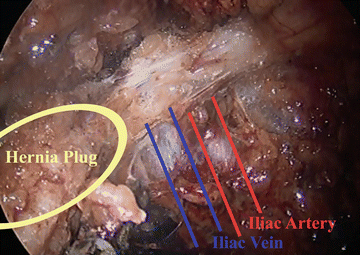Fig. 38.1.
Densely adherent small intestine to prior hernia mesh in retroperitoneal space.
Due to the chronic, non-neuropathic nature of his groin pain, it was felt that all previous mesh would need to be removed at this operation. To facilitate subsequent hernia repair following mesh removal , we began by creating a large, extraperitoneal flap. During this portion, we encountered multiple pieces of prior mesh, all of which were removed with a combination of sharp dissection and harmonic scalpel. Great care was taken to avoid injury to the overlying skin, as the patient was very thin, and there was not a significant amount of subcutaneous tissue. Cooper’s ligament was identified and served as our inferomedial landmark, and dissection was continued laterally. The plug mesh was identified adherent to the vas deferens, as can often be expected. In the complex re-operative setting, we discuss with the patient preoperatively the potential for division of the vas deferens, as often this cannot be preserved. When completing the inferior dissection of the plug, great caution must be used, as it is in close proximity to the iliac artery and vein (Fig. 38.2). The plug mesh was then removed through the umbilical incision. We then turned our attention to removing the remainder of the prior mesh. This was noted to involve the inferior epigastric vessels; to prevent bleeding during this stage, the vessels were prophylactically ligated with a clip. After removal of all of the prior mesh from the abdominal wall, they were removed from the abdomen in a specimen removal bag.


Fig. 38.2.
The prior plug mesh is retracted medially to demonstrate its close proximity to the underlying right iliac artery and vein.
The patient was clearly left with a defect in the groin. We elected to repair this with an extra-large piece of 3DMax Light Mesh (Bard, Warwick, Rhode Island). This is a preformed, lightweight polypropylene mesh with large pores. This was positioned in our extraperitoneal plane and secured in place with selectively placed tacks into Cooper’s ligament. In addition, it is our practice to secure the inferior portion of the hernia mesh with fibrin glue in an effort to prevent recurrence below the mesh. To prevent the mesh from contacting the viscera, it was covered with our previously created peritoneal flap. Prior to completing the procedure, the portion of small bowel that was densely adhered to the mesh was externalized through the umbilical incision to evaluate for any potential injury and was ultimately oversewn.
Stay updated, free articles. Join our Telegram channel

Full access? Get Clinical Tree





